Hospitality Robots Market Size 2025-2029
The hospitality robots market size is valued to increase USD 663.2 million, at a CAGR of 16.7% from 2024 to 2029. Increasing penetration of AI in robots will drive the hospitality robots market.
Major Market Trends & Insights
- North America dominated the market and accounted for a 43% growth during the forecast period.
- By End-user - Hotels segment was valued at USD 202.70 million in 2023
- By Distribution Channel - Online segment accounted for the largest market revenue share in 2023
Market Size & Forecast
- Market Opportunities: USD 272.47 million
- Market Future Opportunities: USD 663.20 million
- CAGR from 2024 to 2029 : 16.7%
Market Summary
- The market is experiencing significant growth, with estimates suggesting it will reach a value of USD 1.5 billion by 2025. This expansion is driven by the increasing integration of artificial intelligence (AI) and the Internet of Things (IoT) into robotic technology. Hospitality robots offer numerous benefits, including improved efficiency, enhanced customer experiences, and reduced labor costs. These robots are not limited to menial tasks such as room service delivery or concierge services. They can also perform complex functions like language translation, facial recognition, and even emotional intelligence. The human-robot interaction is becoming increasingly sophisticated, blurring the lines between human and machine.
- Despite these advancements, the high initial cost of hospitality robots remains a significant challenge. However, the long-term savings and operational efficiencies they provide make them an attractive investment for forward-thinking businesses. As the technology continues to evolve, we can expect to see further innovations in areas such as mobility, design, and cognitive abilities. The future of hospitality is being shaped by these intelligent machines, offering new possibilities for enhancing guest experiences and streamlining operations.
What will be the Size of the Hospitality Robots Market during the forecast period?
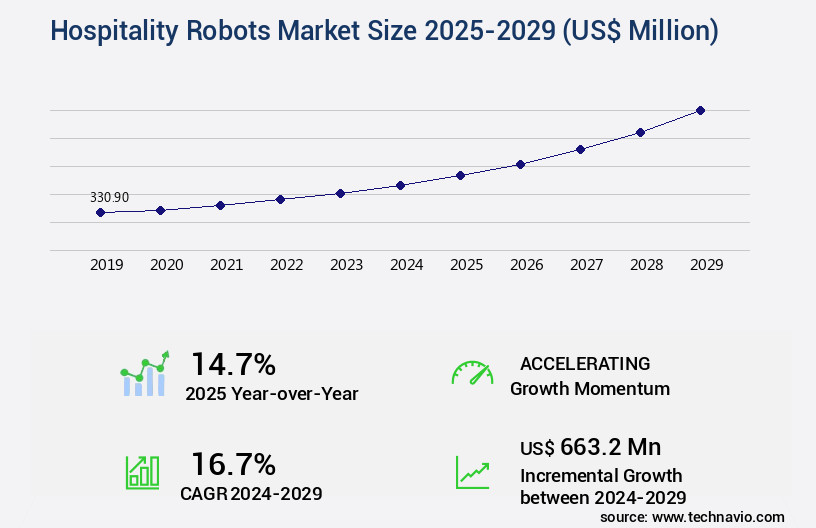
Get Key Insights on Market Forecast (PDF) Request Free Sample
How is the Hospitality Robots Market Segmented?
The hospitality robots industry research report provides comprehensive data (region-wise segment analysis), with forecasts and estimates in "USD million" for the period 2025-2029, as well as historical data from 2019-2023 for the following segments.
- End-user
- Hotels
- Restaurants and bars
- Travel and tourism industry
- Distribution Channel
- Type
- Front Desk Robots
- Delivery Robots
- Cleaning Robots
- Others
- Front Desk Robots
- Delivery Robots
- Cleaning Robots
- Others
- Geography
- North America
- Europe
- APAC
- Australia
- China
- Japan
- South Korea
- Rest of World (ROW)
By End-user Insights
The hotels segment is estimated to witness significant growth during the forecast period.
The hospitality industry's ongoing shift towards automation is driving significant growth in the global robots market, with hotels leading the charge. Marriott and Hilton are among the major players investing in robotic solutions to enhance social distancing and streamline operations. Hospitality robots are increasingly being used for tasks such as housekeeping, cleaning, luggage transport, and room service delivery. According to recent reports, the hotel segment is projected to dominate the market, accounting for over 50% of the total sales. Robots' capabilities include advanced features like slam algorithms, speech recognition software, and object recognition AI, enabling them to navigate autonomously and interact with guests.
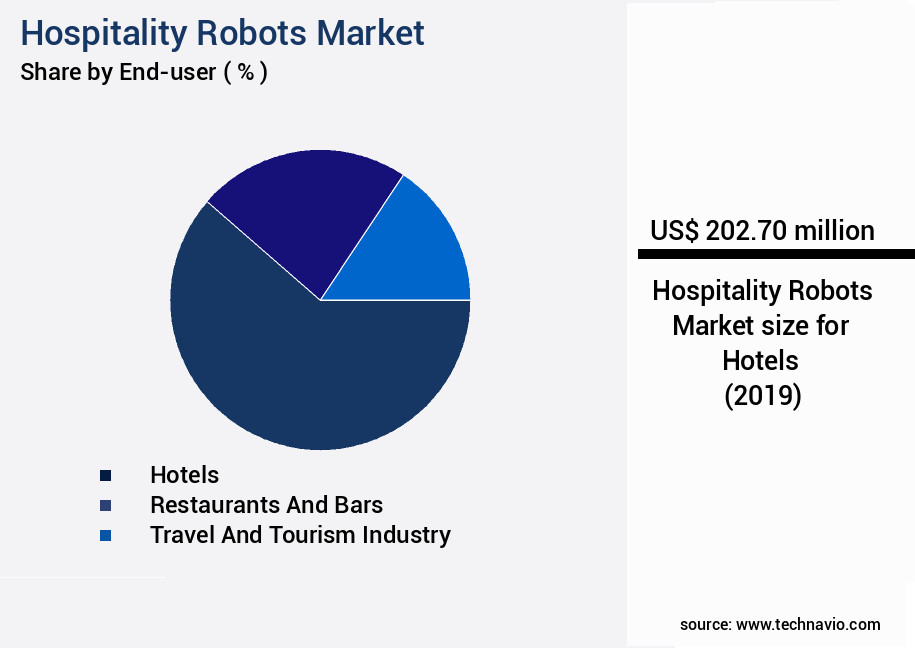
Request Free Sample
The Hotels segment was valued at USD 202.70 million in 2019 and showed a gradual increase during the forecast period.
They offer benefits like operational downtime reduction, increased efficiency, and improved safety protocols. Robots' deployment strategies include logistic support robots, mobile robot platforms, and cleaning robots, among others. The integration of computer vision systems and inventory management systems further enhances their effectiveness. With a focus on battery life optimization, safety protocols, and mobility range efficiency, hospitality robots are set to revolutionize the industry, offering a promising future for hotels and their guests.
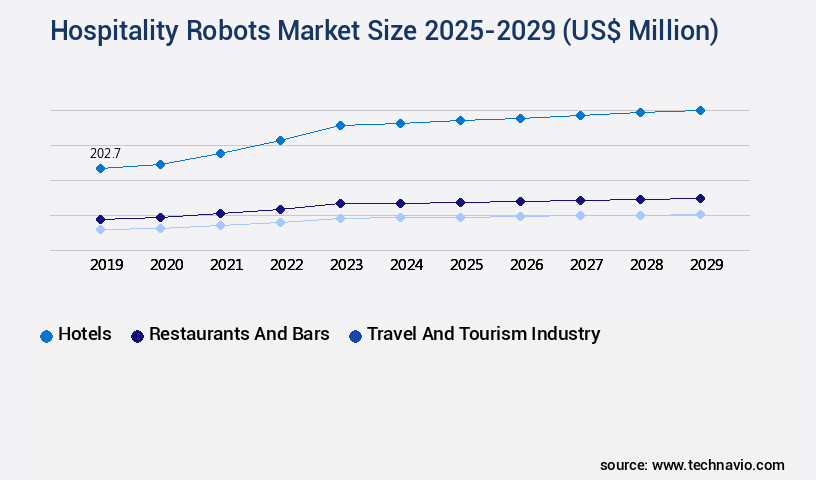
Request Free Sample
Regional Analysis
North America is estimated to contribute 43% to the growth of the global market during the forecast period. Technavio's analysts have elaborately explained the regional trends and drivers that shape the market during the forecast period.
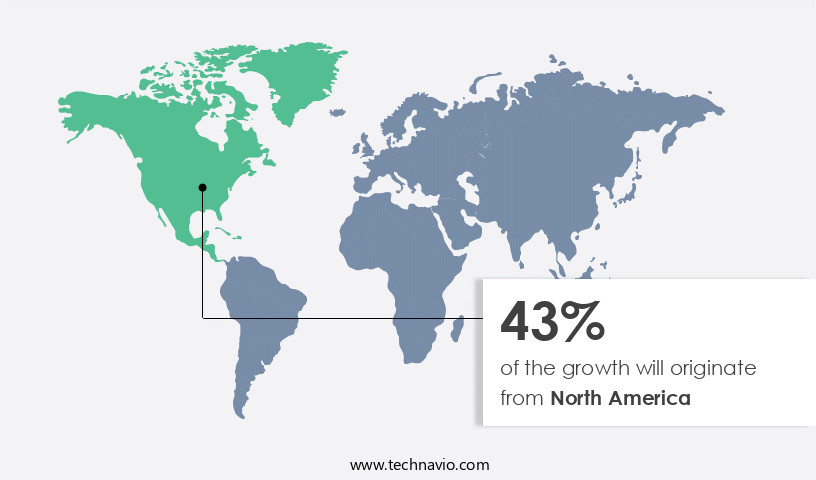
See How Hospitality Robots Market Demand is Rising in North America Request Free Sample
The North American market for hospitality robots has experienced significant growth due to the region's technological advancements and the strong presence of leading suppliers. In March 2023, Honeywell International Inc., based in the United States, introduced an advanced suite of supply chain software to enhance operational efficiencies, boost customer experiences, and facilitate better tracking and monitoring for enterprises. This trend is not limited to Honeywell; numerous hotel and hospitality management cloud software providers in North America primarily cater to small hotels and hotel chains. According to recent studies, the market size was valued at over USD 2 billion in 2021 and is projected to reach approximately USD 5 billion by 2028, growing at a steady rate.
The European market is expected to exhibit substantial growth, with a CAGR of around 18% during the forecast period. These insights underscore the market's potential and the increasing adoption of robots in the hospitality industry.
Market Dynamics
Our researchers analyzed the data with 2024 as the base year, along with the key drivers, trends, and challenges. A holistic analysis of drivers will help companies refine their marketing strategies to gain a competitive advantage.
The market is experiencing significant growth as robotic automation continues to impact the industry. Robots are being implemented in various areas of hospitality to enhance effectiveness and efficiency. For instance, autonomous cleaning robots are revolutionizing housekeeping, while robotic room service is optimizing guest experience and reducing operational costs. However, the implementation of robotic systems in hotels comes with challenges, such as integration with existing infrastructure and training hospitality robot technicians. Despite these challenges, the benefits of robotic automation in the hospitality industry are substantial. Robots can improve guest experience through personalized services offered by robotic concierge services. They can also enhance security measures by monitoring guest areas and providing real-time analytics on robotic system performance metrics. Moreover, robots can help reduce operational costs by automating repetitive tasks and improving staff productivity. When evaluating various robotic platforms, it is essential to consider the comparison of different robot functionalities and the development of future hospitality robots.
Cost-effectiveness is a crucial factor in the adoption of robotic solutions, and scalability is essential for deployment strategies. Maintenance requirements for robotic systems must also be considered to ensure optimal performance. Integration of AI algorithms with robotics is a trend that is gaining popularity in the hospitality industry. This integration can lead to improved guest experiences, increased staff productivity, and enhanced security measures. Training programs for hospitality robot technicians are essential to ensure the successful implementation and maintenance of these systems. In conclusion, the market is transforming the way hotels operate, offering numerous benefits such as improved guest experience, reduced operational costs, and enhanced security measures. However, careful consideration of implementation challenges, integration with existing infrastructure, and maintenance requirements is necessary for a successful deployment of robotic systems in the hospitality industry.
In the rapidly evolving Hospitality Robots Market, the integration of intelligent automation is transforming guest services and operational workflows. The impact robotic automation hospitality has been particularly significant in streamlining routine tasks, enabling staff to focus more on personalized service and complex problem-solving. As robots become more common in hotels, the effectiveness robotic room service is being closely studied, showing promising results in timely deliveries and consistent guest interactions. Among the most widely adopted technologies is the efficiency autonomous cleaning robots, which are redefining housekeeping standards. These robots are capable of maintaining cleanliness with minimal human intervention, increasing overall hygiene while freeing up staff for other duties. Similarly, the optimization robotic concierge services is reshaping front desk operations, with robots providing directions, answering FAQs, and even assisting with check-ins—all with impressive accuracy and speed.
Despite the progress, there are notable hurdles, particularly in the implementation challenges robotic systems hotels face. Issues such as high upfront costs, maintenance requirements, and resistance to change among staff must be carefully managed. Equally important is the integration robotic systems existing infrastructure, as not all properties are designed to support autonomous navigation, charging docks, or IoT connectivity.
Still, many hotels are seeing clear improvements guest experience robots provide. From offering multilingual support to delivering amenities with minimal wait time, robots enhance convenience and novelty, which positively impacts guest satisfaction scores. Moreover, there's a noticeable reduction operational costs robots bring over time, especially in areas like staffing, maintenance, and energy efficiency. Another emerging advantage is the enhancement security measures robots contribute to hotel operations. Surveillance robots and automated systems can monitor hallways, detect unusual activity, and alert human staff in real time, thus adding a layer of safety without disrupting the guest experience.
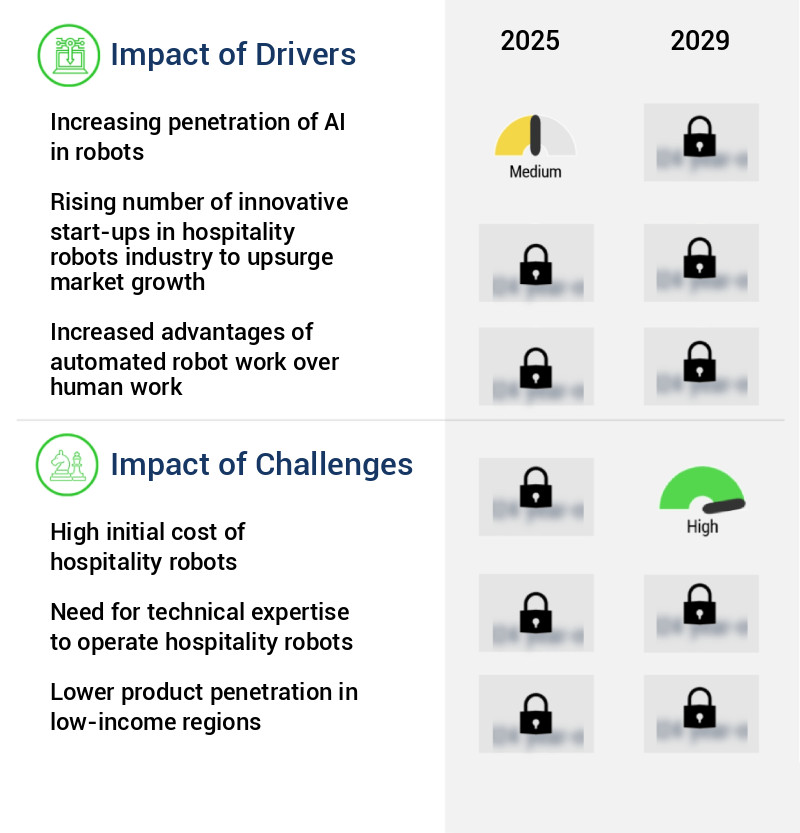
What are the key market drivers leading to the rise in the adoption of Hospitality Robots Industry?
- The integration of artificial intelligence (AI) technology is the primary factor fueling market growth and increasing penetration in robot systems.
- Professional service robots have become indispensable in various industries, including hospitality, by enhancing efficiency and ensuring risk-free operations. In the hotel sector, robots have significantly reduced service delivery times. However, their decision-making abilities are limited to pre-programmed responses, necessitating the integration of Artificial Intelligence (AI). AI, a neural network that replicates human intellect, is increasingly being incorporated into professional service robots. Presently, AI applications in robots predominantly focus on visual systems and machine learning.
- The adoption of AI is expected to augment the capabilities of robots, enabling them to process complex information and make informed decisions. This integration will further optimize the performance of professional service robots in the hospitality industry.
What are the market trends shaping the Hospitality Robots Industry?
- The integration of IoT technology with robots is an emerging market trend. This fusion of IoT and robotics is set to revolutionize industries and automate processes.
- IoT (Internet of Things) technology has experienced a remarkable surge in adoption due to the increasing demand for connected environments. IoT devices utilize sensors and actuators to collect real-time data and transmit it to a centralized location, enabling informed decision-making. This technology's impact is particularly notable in the realm of product customization. Businesses worldwide are integrating their machinery, equipment, and motion control systems to optimize operational processes. The transformation is significant among original equipment manufacturers, driven by the emergence of digital control, wireless communications, low-cost sensors, and remote monitoring, all facilitated by IoT-enabled technologies.
- This shift is leading to increased efficiency and productivity across various sectors. IoT's potential applications are vast, ranging from manufacturing and healthcare to transportation and logistics.
What challenges does the Hospitality Robots Industry face during its growth?
- The high initial cost of hospitality robots represents a significant challenge to the growth of the industry, as this expense can hinder the adoption and implementation of robotic technology in hotels and restaurants.
- The hospitality industry's adoption of robots is evolving, with smaller robots for specific tasks, such as room service delivery and concierge services, priced between USD 5,000 and USD 20,000. Larger, more sophisticated robots, featuring AI, autonomous navigation, and multi-functional capabilities, can cost between USD 20,000 and USD 100,000 or more. Customization options, maintenance contracts, and training programs may also add to the initial investment. The average cost of hospitality robots falls within the range of USD 10,000 to USD 50,000, with variations depending on specific requirements and market trends.
- These robots are revolutionizing various sectors, including hotels, restaurants, and cruise ships, by enhancing guest experiences, improving operational efficiency, and ensuring consistent service quality.
Exclusive Technavio Analysis on Customer Landscape
The hospitality robots market forecasting report includes the adoption lifecycle of the market, covering from the innovator's stage to the laggard's stage. It focuses on adoption rates in different regions based on penetration. Furthermore, the hospitality robots market report also includes key purchase criteria and drivers of price sensitivity to help companies evaluate and develop their market growth analysis strategies.
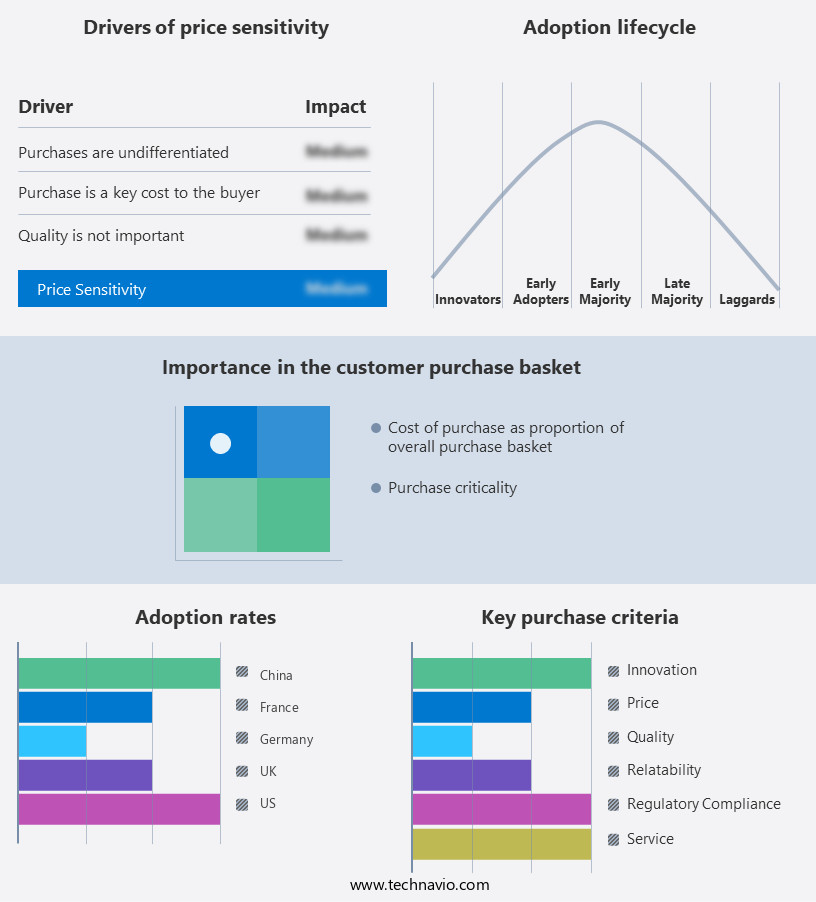
Customer Landscape of Hospitality Robots Industry
Competitive Landscape
Companies are implementing various strategies, such as strategic alliances, hospitality robots market forecast, partnerships, mergers and acquisitions, geographical expansion, and product/service launches, to enhance their presence in the industry.
Awabot - This company specializes in advanced hospitality technology, providing remote-controlled telepresence robots with wireless internet connectivity for enhanced guest experiences.
The industry research and growth report includes detailed analyses of the competitive landscape of the market and information about key companies, including:
- Awabot
- Bear Robotics Inc.
- Connected Robotics Inc.
- Hyundai Motor Co.
- Keenon Robotics Co. Ltd.
- Knightscope Inc.
- LG Corp.
- Pudu Technology Inc.
- Pypestream Inc.
- Quantum Robotics
- Relay Robotics Inc.
- Richtech Robotics Inc.
- SAR Elektronic GmbH
- Shanghai Gaussian Automation Tech. Dev. Co. Ltd.
- ST Engineering Aethon Inc.
- sliQue Robotics and Technology
- SoftBank Robotics Group Corp.
- Tailos
- UBTECH Robotics Inc.
Qualitative and quantitative analysis of companies has been conducted to help clients understand the wider business environment as well as the strengths and weaknesses of key industry players. Data is qualitatively analyzed to categorize companies as pure play, category-focused, industry-focused, and diversified; it is quantitatively analyzed to categorize companies as dominant, leading, strong, tentative, and weak.
Recent Development and News in Hospitality Robots Market
- In January 2024, SoftBank Robotics, a leading robotics company, announced the global launch of Pepper Robot in the hospitality industry. Pepper, a humanoid robot designed for customer engagement, was deployed in several hotels to enhance guest experiences (SoftBank Robotics Press Release, 2024).
- In March 2024, Marriott International, the world's largest hotel chain, entered into a strategic partnership with Savioke, a leading robotics company, to deploy Relay robots in their properties. Relay robots were designed to deliver guest requests, providing contactless services and improving operational efficiency (Marriott International Press Release, 2024).
- In May 2024, Starwood Hotels & Resorts Worldwide, a subsidiary of Marriott International, raised USD10 million in a funding round to expand its robotics program. The investment was led by SoftBank Investment Advisers, the investment management subsidiary of SoftBank Group (Business Wire, 2024).
- In April 2025, Hilton Worldwide Holdings, Inc. received regulatory approval from the U.S. Food and Drug Administration (FDA) for its new robot, Wayfinder, designed to assist guests with mobility challenges. Wayfinder was the first hospitality robot to receive FDA approval for its mobility assistance features (Hilton Worldwide Holdings, Inc. Press Release, 2025).
Dive into Technavio's robust research methodology, blending expert interviews, extensive data synthesis, and validated models for unparalleled Hospitality Robots Market insights. See full methodology.
|
Market Scope
|
|
Report Coverage
|
Details
|
|
Page number
|
196
|
|
Base year
|
2024
|
|
Historic period
|
2019-2023 |
|
Forecast period
|
2025-2029
|
|
Growth momentum & CAGR
|
Accelerate at a CAGR of 16.7%
|
|
Market growth 2025-2029
|
USD 663.2 million
|
|
Market structure
|
Fragmented
|
|
YoY growth 2024-2025(%)
|
14.7
|
|
Key countries
|
US, Canada, Germany, UK, China, France, South Korea, Japan, Australia, and Italy
|
|
Competitive landscape
|
Leading Companies, Market Positioning of Companies, Competitive Strategies, and Industry Risks
|
Request Free Sample
Research Analyst Overview
- The hospitality industry's embrace of robotic technology continues to evolve, with new applications and advancements shaping market dynamics. Robot deployment strategies have expanded beyond logistic support and maintenance tasks to include room service delivery, concierge functions, and even restaurant table service. For instance, a major hotel chain reported a 20% increase in sales due to the implementation of mobile robot platforms for room service delivery. Moreover, the integration of payload capacity limits, SLAM algorithms, and robotic arm manipulation enables these machines to handle a wider range of tasks. Speech recognition software and autonomous navigation systems facilitate seamless human-robot interaction, while computer vision systems and object recognition AI improve cleaning robot efficiency and disinfection UV robots' effectiveness.
- Industry growth in the hospitality robotics market is projected to reach double-digit percentages, with operational downtime reduction, safety protocols, and inventory management systems among the primary drivers. The integration of cloud-based robot control, task scheduling algorithms, and staff training programs further optimizes service efficiency metrics, while fleet management software and emergency stop mechanisms ensure safety. Battery life optimization, path planning optimization, and sensor fusion technology contribute to mobility range efficiency, enabling robots to cover larger areas and reduce power consumption. Data analytics dashboards and robot maintenance schedules provide valuable insights into performance and upkeep, ensuring optimal functionality and a positive guest experience.
What are the Key Data Covered in this Hospitality Robots Market Research and Growth Report?
-
What is the expected growth of the Hospitality Robots Market between 2025 and 2029?
-
What segmentation does the market report cover?
-
The report is segmented by End-user (Hotels, Restaurants and bars, and Travel and tourism industry), Distribution Channel (Online and Offline), Geography (North America, Europe, APAC, South America, and Middle East and Africa), and Type (Front Desk Robots, Delivery Robots, Cleaning Robots, Others, Front Desk Robots, Delivery Robots, Cleaning Robots, and Others)
-
Which regions are analyzed in the report?
-
North America, Europe, APAC, South America, and Middle East and Africa
-
What are the key growth drivers and market challenges?
-
Who are the major players in the Hospitality Robots Market?
-
Awabot, Bear Robotics Inc., Connected Robotics Inc., Hyundai Motor Co., Keenon Robotics Co. Ltd., Knightscope Inc., LG Corp., Pudu Technology Inc., Pypestream Inc., Quantum Robotics, Relay Robotics Inc., Richtech Robotics Inc., SAR Elektronic GmbH, Shanghai Gaussian Automation Tech. Dev. Co. Ltd., ST Engineering Aethon Inc., sliQue Robotics and Technology, SoftBank Robotics Group Corp., Tailos, and UBTECH Robotics Inc.
Market Research Insights
- The market for hospitality robots is a dynamic and ever-evolving sector, characterized by continuous innovation and advancement. Two significant developments in this domain are the integration of user interface design to enhance the interaction between humans and robots, and the implementation of predictive maintenance systems to optimize robot performance and longevity. For instance, a leading hotel chain reported a 20% increase in customer satisfaction ratings following the deployment of robots with advanced user interface designs.
- Moreover, industry experts anticipate that the hospitality robotics market will expand by 15% annually over the next five years, driven by the growing demand for automation in various sectors.
We can help! Our analysts can customize this hospitality robots market research report to meet your requirements.
Get in touch
1 Executive Summary
- 1.1 Market overview
- Executive Summary - Chart on Market Overview
- Executive Summary - Data Table on Market Overview
- Executive Summary - Chart on Global Market Characteristics
- Executive Summary - Chart on Market by Geography
- Executive Summary - Chart on Market Segmentation by End-user
- Executive Summary - Chart on Market Segmentation by Distribution Channel
- Executive Summary - Chart on Incremental Growth
- Executive Summary - Data Table on Incremental Growth
- Executive Summary - Chart on Company Market Positioning
2 Technavio Analysis
- 2.1 Analysis of price sensitivity, lifecycle, customer purchase basket, adoption rates, and purchase criteria
- Analysis of price sensitivity, lifecycle, customer purchase basket, adoption rates, and purchase criteria
- 2.2 Criticality of inputs and Factors of differentiation
- Overview on criticality of inputs and factors of differentiation
- 2.3 Factors of disruption
- Overview on factors of disruption
- 2.4 Impact of drivers and challenges
- Impact of drivers and challenges in 2024 and 2029
3 Market Landscape
- 3.1 Market ecosystem
- Parent Market
- Data Table on - Parent Market
- 3.2 Market characteristics
- Market characteristics analysis
4 Market Sizing
- 4.1 Market definition
- Offerings of companies included in the market definition
- 4.2 Market segment analysis
- 4.4 Market outlook: Forecast for 2024-2029
- Chart on Global - Market size and forecast 2024-2029 ($ million)
- Data Table on Global - Market size and forecast 2024-2029 ($ million)
- Chart on Global Market: Year-over-year growth 2024-2029 (%)
- Data Table on Global Market: Year-over-year growth 2024-2029 (%)
5 Historic Market Size
- 5.1 Global Hospitality Robots Market 2019 - 2023
- Historic Market Size - Data Table on Global Hospitality Robots Market 2019 - 2023 ($ million)
- 5.2 End-user segment analysis 2019 - 2023
- Historic Market Size - End-user Segment 2019 - 2023 ($ million)
- 5.3 Distribution Channel segment analysis 2019 - 2023
- Historic Market Size - Distribution Channel Segment 2019 - 2023 ($ million)
- 5.4 Geography segment analysis 2019 - 2023
- Historic Market Size - Geography Segment 2019 - 2023 ($ million)
- 5.5 Country segment analysis 2019 - 2023
- Historic Market Size - Country Segment 2019 - 2023 ($ million)
6 Qualitative Analysis
- 6.1 The AI impact on global hospitality robots market
7 Five Forces Analysis
- 7.1 Five forces summary
- Five forces analysis - Comparison between 2024 and 2029
- 7.2 Bargaining power of buyers
- Bargaining power of buyers - Impact of key factors 2024 and 2029
- 7.3 Bargaining power of suppliers
- Bargaining power of suppliers - Impact of key factors in 2024 and 2029
- 7.4 Threat of new entrants
- Threat of new entrants - Impact of key factors in 2024 and 2029
- 7.5 Threat of substitutes
- Threat of substitutes - Impact of key factors in 2024 and 2029
- 7.6 Threat of rivalry
- Threat of rivalry - Impact of key factors in 2024 and 2029
- 7.7 Market condition
- Chart on Market condition - Five forces 2024 and 2029
8 Market Segmentation by End-user
- 8.1 Market segments
- Chart on End-user - Market share 2024-2029 (%)
- Data Table on End-user - Market share 2024-2029 (%)
- 8.2 Comparison by End-user
- Chart on Comparison by End-user
- Data Table on Comparison by End-user
- 8.3 Hotels - Market size and forecast 2024-2029
- Chart on Hotels - Market size and forecast 2024-2029 ($ million)
- Data Table on Hotels - Market size and forecast 2024-2029 ($ million)
- Chart on Hotels - Year-over-year growth 2024-2029 (%)
- Data Table on Hotels - Year-over-year growth 2024-2029 (%)
- 8.4 Restaurants and bars - Market size and forecast 2024-2029
- Chart on Restaurants and bars - Market size and forecast 2024-2029 ($ million)
- Data Table on Restaurants and bars - Market size and forecast 2024-2029 ($ million)
- Chart on Restaurants and bars - Year-over-year growth 2024-2029 (%)
- Data Table on Restaurants and bars - Year-over-year growth 2024-2029 (%)
- 8.5 Travel and tourism industry - Market size and forecast 2024-2029
- Chart on Travel and tourism industry - Market size and forecast 2024-2029 ($ million)
- Data Table on Travel and tourism industry - Market size and forecast 2024-2029 ($ million)
- Chart on Travel and tourism industry - Year-over-year growth 2024-2029 (%)
- Data Table on Travel and tourism industry - Year-over-year growth 2024-2029 (%)
- 8.6 Market opportunity by End-user
- Market opportunity by End-user ($ million)
- Data Table on Market opportunity by End-user ($ million)
9 Market Segmentation by Distribution Channel
- 9.1 Market segments
- Chart on Distribution Channel - Market share 2024-2029 (%)
- Data Table on Distribution Channel - Market share 2024-2029 (%)
- 9.2 Comparison by Distribution Channel
- Chart on Comparison by Distribution Channel
- Data Table on Comparison by Distribution Channel
- 9.3 Online - Market size and forecast 2024-2029
- Chart on Online - Market size and forecast 2024-2029 ($ million)
- Data Table on Online - Market size and forecast 2024-2029 ($ million)
- Chart on Online - Year-over-year growth 2024-2029 (%)
- Data Table on Online - Year-over-year growth 2024-2029 (%)
- 9.4 Offline - Market size and forecast 2024-2029
- Chart on Offline - Market size and forecast 2024-2029 ($ million)
- Data Table on Offline - Market size and forecast 2024-2029 ($ million)
- Chart on Offline - Year-over-year growth 2024-2029 (%)
- Data Table on Offline - Year-over-year growth 2024-2029 (%)
- 9.5 Market opportunity by Distribution Channel
- Market opportunity by Distribution Channel ($ million)
- Data Table on Market opportunity by Distribution Channel ($ million)
10 Market Segmentation by Type
- 10.1 Market segments
- Chart on Type - Market share (2024-2029) (%)
- Data Table on Type - Market share (2024-2029) (%)
- 10.2 Comparison by Type
- Chart on Comparison by Type
- Data Table on Comparison by Type
- 10.3 Front Desk Robots - Market size and forecast (2024-2029)
- Chart on Front Desk Robots - Market size and forecast (2024-2029) ($ million)
- Data Table on Front Desk Robots - Market size and forecast (2024-2029) ($ million)
- Chart on Front Desk Robots - Year-over-year growth (2024-2029) (%)
- Data Table on Front Desk Robots - Year-over-year growth (2024-2029) (%)
- 10.4 Delivery Robots - Market size and forecast (2024-2029)
- Chart on Delivery Robots - Market size and forecast (2024-2029) ($ million)
- Data Table on Delivery Robots - Market size and forecast (2024-2029) ($ million)
- Chart on Delivery Robots - Year-over-year growth (2024-2029) (%)
- Data Table on Delivery Robots - Year-over-year growth (2024-2029) (%)
- 10.5 Cleaning Robots - Market size and forecast (2024-2029)
- Chart on Cleaning Robots - Market size and forecast (2024-2029) ($ million)
- Data Table on Cleaning Robots - Market size and forecast (2024-2029) ($ million)
- Chart on Cleaning Robots - Year-over-year growth (2024-2029) (%)
- Data Table on Cleaning Robots - Year-over-year growth (2024-2029) (%)
- 10.6 Others - Market size and forecast (2024-2029)
- Chart on Others - Market size and forecast (2024-2029) ($ million)
- Data Table on Others - Market size and forecast (2024-2029) ($ million)
- Chart on Others - Year-over-year growth (2024-2029) (%)
- Data Table on Others - Year-over-year growth (2024-2029) (%)
- 10.7 Market opportunity by Type
- Market opportunity by $segment_name ($ million)
- Data Table on Market opportunity by $segment_name ($ million)
11 Customer Landscape
- 11.1 Customer landscape overview
- Analysis of price sensitivity, lifecycle, customer purchase basket, adoption rates, and purchase criteria
12 Geographic Landscape
- 12.1 Geographic segmentation
- Chart on Market share by geography 2024-2029 (%)
- Data Table on Market share by geography 2024-2029 (%)
- 12.2 Geographic comparison
- Chart on Geographic comparison
- Data Table on Geographic comparison
- 12.3 North America - Market size and forecast 2024-2029
- Chart on North America - Market size and forecast 2024-2029 ($ million)
- Data Table on North America - Market size and forecast 2024-2029 ($ million)
- Chart on North America - Year-over-year growth 2024-2029 (%)
- Data Table on North America - Year-over-year growth 2024-2029 (%)
- 12.4 Europe - Market size and forecast 2024-2029
- Chart on Europe - Market size and forecast 2024-2029 ($ million)
- Data Table on Europe - Market size and forecast 2024-2029 ($ million)
- Chart on Europe - Year-over-year growth 2024-2029 (%)
- Data Table on Europe - Year-over-year growth 2024-2029 (%)
- 12.5 APAC - Market size and forecast 2024-2029
- Chart on APAC - Market size and forecast 2024-2029 ($ million)
- Data Table on APAC - Market size and forecast 2024-2029 ($ million)
- Chart on APAC - Year-over-year growth 2024-2029 (%)
- Data Table on APAC - Year-over-year growth 2024-2029 (%)
- 12.6 South America - Market size and forecast 2024-2029
- Chart on South America - Market size and forecast 2024-2029 ($ million)
- Data Table on South America - Market size and forecast 2024-2029 ($ million)
- Chart on South America - Year-over-year growth 2024-2029 (%)
- Data Table on South America - Year-over-year growth 2024-2029 (%)
- 12.7 Middle East and Africa - Market size and forecast 2024-2029
- Chart on Middle East and Africa - Market size and forecast 2024-2029 ($ million)
- Data Table on Middle East and Africa - Market size and forecast 2024-2029 ($ million)
- Chart on Middle East and Africa - Year-over-year growth 2024-2029 (%)
- Data Table on Middle East and Africa - Year-over-year growth 2024-2029 (%)
- 12.8 US - Market size and forecast 2024-2029
- Chart on US - Market size and forecast 2024-2029 ($ million)
- Data Table on US - Market size and forecast 2024-2029 ($ million)
- Chart on US - Year-over-year growth 2024-2029 (%)
- Data Table on US - Year-over-year growth 2024-2029 (%)
- 12.9 Canada - Market size and forecast 2024-2029
- Chart on Canada - Market size and forecast 2024-2029 ($ million)
- Data Table on Canada - Market size and forecast 2024-2029 ($ million)
- Chart on Canada - Year-over-year growth 2024-2029 (%)
- Data Table on Canada - Year-over-year growth 2024-2029 (%)
- 12.10 Germany - Market size and forecast 2024-2029
- Chart on Germany - Market size and forecast 2024-2029 ($ million)
- Data Table on Germany - Market size and forecast 2024-2029 ($ million)
- Chart on Germany - Year-over-year growth 2024-2029 (%)
- Data Table on Germany - Year-over-year growth 2024-2029 (%)
- 12.11 UK - Market size and forecast 2024-2029
- Chart on UK - Market size and forecast 2024-2029 ($ million)
- Data Table on UK - Market size and forecast 2024-2029 ($ million)
- Chart on UK - Year-over-year growth 2024-2029 (%)
- Data Table on UK - Year-over-year growth 2024-2029 (%)
- 12.12 China - Market size and forecast 2024-2029
- Chart on China - Market size and forecast 2024-2029 ($ million)
- Data Table on China - Market size and forecast 2024-2029 ($ million)
- Chart on China - Year-over-year growth 2024-2029 (%)
- Data Table on China - Year-over-year growth 2024-2029 (%)
- 12.13 South Korea - Market size and forecast 2024-2029
- Chart on South Korea - Market size and forecast 2024-2029 ($ million)
- Data Table on South Korea - Market size and forecast 2024-2029 ($ million)
- Chart on South Korea - Year-over-year growth 2024-2029 (%)
- Data Table on South Korea - Year-over-year growth 2024-2029 (%)
- 12.14 France - Market size and forecast 2024-2029
- Chart on France - Market size and forecast 2024-2029 ($ million)
- Data Table on France - Market size and forecast 2024-2029 ($ million)
- Chart on France - Year-over-year growth 2024-2029 (%)
- Data Table on France - Year-over-year growth 2024-2029 (%)
- 12.15 Japan - Market size and forecast 2024-2029
- Chart on Japan - Market size and forecast 2024-2029 ($ million)
- Data Table on Japan - Market size and forecast 2024-2029 ($ million)
- Chart on Japan - Year-over-year growth 2024-2029 (%)
- Data Table on Japan - Year-over-year growth 2024-2029 (%)
- 12.16 Australia - Market size and forecast 2024-2029
- Chart on Australia - Market size and forecast 2024-2029 ($ million)
- Data Table on Australia - Market size and forecast 2024-2029 ($ million)
- Chart on Australia - Year-over-year growth 2024-2029 (%)
- Data Table on Australia - Year-over-year growth 2024-2029 (%)
- 12.17 Italy - Market size and forecast 2024-2029
- Chart on Italy - Market size and forecast 2024-2029 ($ million)
- Data Table on Italy - Market size and forecast 2024-2029 ($ million)
- Chart on Italy - Year-over-year growth 2024-2029 (%)
- Data Table on Italy - Year-over-year growth 2024-2029 (%)
- 12.18 Market opportunity by geography
- Market opportunity by geography ($ million)
- Data Tables on Market opportunity by geography ($ million)
13 Drivers, Challenges, and Opportunity/Restraints
- 13.3 Impact of drivers and challenges
- Impact of drivers and challenges in 2024 and 2029
- 13.4 Market opportunities/restraints
14 Competitive Landscape
- 14.2 Competitive Landscape
- Overview on criticality of inputs and factors of differentiation
- 14.3 Landscape disruption
- Overview on factors of disruption
- 14.4 Industry risks
- Impact of key risks on business
15 Competitive Analysis
- 15.2 Company ranking index
- 15.3 Market positioning of companies
- Matrix on companies position and classification
- 15.4 Awabot
- Awabot - Overview
- Awabot - Product / Service
- Awabot - Key offerings
- SWOT
- 15.5 Bear Robotics Inc.
- Bear Robotics Inc. - Overview
- Bear Robotics Inc. - Product / Service
- Bear Robotics Inc. - Key offerings
- SWOT
- 15.6 Connected Robotics Inc.
- Connected Robotics Inc. - Overview
- Connected Robotics Inc. - Product / Service
- Connected Robotics Inc. - Key offerings
- SWOT
- 15.7 Hyundai Motor Co.
- Hyundai Motor Co. - Overview
- Hyundai Motor Co. - Business segments
- Hyundai Motor Co. - Key news
- Hyundai Motor Co. - Key offerings
- Hyundai Motor Co. - Segment focus
- SWOT
- 15.8 Keenon Robotics Co. Ltd.
- Keenon Robotics Co. Ltd. - Overview
- Keenon Robotics Co. Ltd. - Product / Service
- Keenon Robotics Co. Ltd. - Key offerings
- SWOT
- 15.9 Knightscope Inc.
- Knightscope Inc. - Overview
- Knightscope Inc. - Product / Service
- Knightscope Inc. - Key news
- Knightscope Inc. - Key offerings
- SWOT
- 15.10 LG Corp.
- LG Corp. - Overview
- LG Corp. - Product / Service
- LG Corp. - Key offerings
- SWOT
- 15.11 Pudu Technology Inc.
- Pudu Technology Inc. - Overview
- Pudu Technology Inc. - Product / Service
- Pudu Technology Inc. - Key offerings
- SWOT
- 15.12 Quantum Robotics
- Quantum Robotics - Overview
- Quantum Robotics - Product / Service
- Quantum Robotics - Key offerings
- SWOT
- 15.13 Relay Robotics Inc.
- Relay Robotics Inc. - Overview
- Relay Robotics Inc. - Product / Service
- Relay Robotics Inc. - Key offerings
- SWOT
- 15.14 Richtech Robotics Inc.
- Richtech Robotics Inc. - Overview
- Richtech Robotics Inc. - Product / Service
- Richtech Robotics Inc. - Key offerings
- SWOT
- 15.15 ST Engineering Aethon Inc.
- ST Engineering Aethon Inc. - Overview
- ST Engineering Aethon Inc. - Product / Service
- ST Engineering Aethon Inc. - Key offerings
- SWOT
- 15.16 SoftBank Robotics Group Corp.
- SoftBank Robotics Group Corp. - Overview
- SoftBank Robotics Group Corp. - Product / Service
- SoftBank Robotics Group Corp. - Key offerings
- SWOT
- 15.17 Tailos
- Tailos - Overview
- Tailos - Product / Service
- Tailos - Key offerings
- SWOT
- 15.18 UBTECH Robotics Inc.
- UBTECH Robotics Inc. - Overview
- UBTECH Robotics Inc. - Product / Service
- UBTECH Robotics Inc. - Key news
- UBTECH Robotics Inc. - Key offerings
- SWOT
16 Appendix
- 16.2 Inclusions and exclusions checklist
- Inclusions checklist
- Exclusions checklist
- 16.3 Currency conversion rates for US$
- Currency conversion rates for US$
- 16.4 Research methodology
- 16.7 Validation techniques employed for market sizing
- Validation techniques employed for market sizing
- 16.9 360 degree market analysis
- 360 degree market analysis
- 16.10 List of abbreviations







![]() Get the report (PDF) sent to your email within minutes.
Get the report (PDF) sent to your email within minutes.
Complimentary full Excel data with your report purchase.